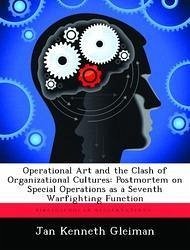As the United States Army stands in the midst of a transitional period, it must determine what type of Army it will be. In doing so, the Army must come to grips with new realities of the strategic context that demand a capability to use "Engagement" as defined in the National Security Strategy and an inculcation of "Operational adaptability" as defined in the Army Capstone Concept. Recently, the United States Army Special Operations Command (USASOC) proposed a change to Army doctrine that would have made Special Operations a seventh warfighting function for the Army. The proposal failed to pass and the Army is now taking a much slower approach to changes. This monograph uses this failed proposal as a singular case study, or micro-event that illuminates a macro-phenomenon, which could be preventing the Army from meeting its challenges of engagement and operational adaptability. Using key elements of organization theory as a lens for understanding why the proposal failed, this monograph applies process tracing and argument mapping. It demonstrates that the fragmented organizational sub-culture of SOF may have influenced not only the failure of the proposal, but also continues to prevent the Army from leveraging the institutional strength of the SOF community toward engagement and operational adaptability.








